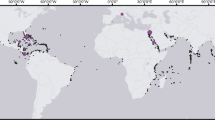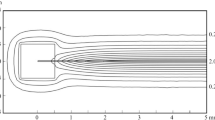Abstract
We have investigated the effect of high hydrostatic pressure on MscS, the bacterial mechanosensitive channel of small conductance. Pressure affected channel kinetics but not conductance. At negative pipette voltages (corresponding to membrane depolarization in the inside-out patch configuration used in our experiments) the channel exhibited a reversible reduction in activity with increasing hydrostatic pressure between 0 and 900 atm (90 MPa) at 23°C. The reduced activity was characterized by a significant reduction in the channel opening probability resulting from a shortening of the channel openings with increasing pressure. Thus high hydrostatic pressure generally favoured channel closing. Cooling the patch by approximately 10°C, intended to order the bilayer component of the patch by an amount similar to that caused by 50 MPa at 23°C, had relatively little effect. This implies that pressure does not affect channel kinetics via bilayer order. Accordingly we postulate that lateral compression of the bilayer, under high hydrostatic pressure, is responsible. These observations also have implications for our understanding of the adaptation of mechanosensitive channels in deep-sea bacteria.






Similar content being viewed by others
References
Balny C, Masson P, Heremans K (2002) Frontiers in high pressure biochemistry and biophysics. Elsevier, Amsterdam
Bartlett DH (2002) Pressure effects on in vivo microbial processes. Biochim Biophys Acta 1595:367–381
Bass R et al (2002) Crystal structure of Escherichia coli MscS, a voltage-modulated and mechanosensitive channel. Science 298:1582–1587
Beney L, Perrier-Cornet JM, Wayert M, Gervais P (1997) Modification of phospholipid vesicles induced by high pressure: influence of bilayer compressibility. Biophys J 72:1258–1263
Berrier C, Coulombe A, Houssin C, Ghazi A (1989) A patch-clamp study of inner and outer membranes and of contact zones of E. coli, fused into giant liposomes pressure-activated channels are localized in the inner membrane. FEBS Lett 259:27–32
Berrier C, Besnard M, Ajouz B, Coulombe A, Ghazi A (1996) Multiple mechanosensitive ion channels from Escherichia coli, activated at different thresholds of applied pressure. J Membr Biol 151:175–187
Braganza LF, Worcester DL (1986) Structural changes in lipid bilayers and biological membranes caused by hydrostatic pressure. Biochemistry 25:7484–7488
Conti F, Inoue I, Kukuita F, Stuhmer W (1984) Pressure dependence of sodium gating currents. Eur J Biophys 11:137–147
Cossins AR, Macdonald AG (1989) The adaptation of biological membranes to temperature and pressure: fish from the deep and the cold. J Bioenerg Biomembr 21:115–135
Czeslik C, Reis O, Winter R, Rapp G (1998) Effects of high pressure on the structure of dipalmitoylphosphatidylcholine bilayer membranes. Chem Phys Lipids 91:135–144
De Long EF, Yayanos AA (1985) Adaptation of the membrane lipids of a deep sea bacterium to changes in hydrostatic pressure. Science 228:1101–1103
Delcour AH, Martinac B, Adler A, Kung C (1989) Modified reconstitution method used in patch-clamp studies of Escherichia coli ion channels. Biophys J 56:631–636
Disteche A (1972) Effects of pressure on the dissociation of weak acids. Symp Soc Exp Biol 26:27–60
Dobson J, Stewart Z, Martinac B (2002) Preliminary evidence for weak magnetic field effects on mechanosensitive ion channel subconducting states in Escherichia coli. Electromagn Biol Med 21(1):89–95
Gibbs AG (1997) Biochemistry at depth. In: Randall DJ, Farell AP (eds) Deep sea fishes. Academic Press, New York London, pp 239–277
Hamill OP, Martinac B (2001) Molecular basis of mechanotransduction in living cells. Physiol Rev 81:685–740
Heinemann SH, Stühmner W, Conti F (1987) Single acetylcholine receptor-channel currents recorded at high hydrostatic pressure. Proc Natl Acad Sci USA 84:3229–3233
Kendig JJ, Grossman Y, Heinemann SH (1993) Ion channels and nerve cell function. In: Macdonald AG (ed) Effects of high pressure on biological systems. Springer-Verlag, Hiedelberg, pp 88–124
Kloda A, Martinac B (2001) Structural and functional similarities and differences between MscMJLR and MscMJ, two homologous MS channels of M. jannashii. EMBO J 20:1888–1896
Macdonald AG (1997) Effect of high hydrostatic pressure on the BK channel in bovine chromaffin cells. Biophys J 73:1866–1873
Macdonald AG (2001a) High hydrostatic pressure activates BK channels. Biophys J 80:888 (Abstract)
Macdonald AG (2001b) Effects of high pressure on cellular processes. In: Sperelakis N (ed) Cell physiology sourcebook. A molecular approach. Academic Press, San Diego, pp 1003–1023
Macdonald AG (2002a) Ion channels under high pressure. Comp Biochem Physiol A 131:587–593
Macdonald AG (2002b) Experiments on ion channels at high pressure. Biochim Biophys Acta 1595:387–389
Macdonald AG, Martinac B (1999) Effect of high hydrostatic pressure on the porin OmpC from Escherichia coli. FEMS Microbial Lett 173:327–334
Martinac B (2004) Mechanosensitive ion channels: molecules of mechanotransduction. J Cell Sci 117:2449–2460
Martinac B, Kloda A (2003) Evolutionary origins of mechanosensitive ion channels. Prog Biophys Mol Biol 82:11–24
Martinac B, Buechner M, Delcour AH, Adler J, Kung C (1987) Pressure-sensitive ion channel in Escherichia coli. Proc Natl Acad Sci USA 84:2297–2301
Martinac B, Adler J, Kung C (1990) Mechanosensitive ion channels of E. coli activated by amphipaths. Nature 348:261–263
Meyer R, Heinemann SH (1997) Temperature and pressure dependence of Shaker K+ channel N-type and C-type inactivation. Eur Biophys J 26:433–445
Morris CE (1990) Mechanosensitive ion channels. J Membr Biol 113:93–107
Perozo E, Kloda A, Cortes DM, Martinac B (2002) Physical principles underlying the transduction of bilayer deformation forces during mechanosensitive channel gating. Nat Struct Biol 9:696–703
Ruthe HJ, Adler J (1985) Fusion of bacterial spheroplasts by electric fields. Biochim Biophys Acta 25(1):105–113
Sachs F (1988) Mechanical transduction in biological systems. CRC Crit Rev Biomed Eng 16:141–169
Sachs F, Morris CE (1998) Mechanosensitive ion channels in nonspecialized cells. Rev Physiol Biochem Pharmacol 132:1–77
Somero GN (1990) Life at low volume change: hydrostatic pressure as a selective factor in the aquatic environment. Am Zool 30:123–135
Sukharev S (2002) Purification of the small mechanosensitive channel of Escherichia coli (MscS): the subunit structure, conduction, and gating characteristics in liposomes. Biophys J 83:290–298
Sukharev SI, Corey D (2004) Mechanosensitive channels: multiplicity of families and gating paradigms. Science’s STKE http://www.stke.org/cgi/content/full/sigtrans; 2004/219/re4, pp 1–24
Sukharev SI, Blount P, Martinac B, Kung C (1997) Mechanosensitive channels of Escherichia coli: the MscL gene, protein and activities. Annu Rev Physiol 59:633–657
Acknowledgement
This work was supported by the Australian Research Council.
Author information
Authors and Affiliations
Corresponding author
Additional information
A Proceeding of the 28th Annual Meeting of the Australian Society for Biophysics.
Rights and permissions
About this article
Cite this article
Macdonald, A.G., Martinac, B. Effect of high hydrostatic pressure on the bacterial mechanosensitive channel MscS. Eur Biophys J 34, 434–441 (2005). https://doi.org/10.1007/s00249-005-0478-8
Received:
Revised:
Accepted:
Published:
Issue Date:
DOI: https://doi.org/10.1007/s00249-005-0478-8




